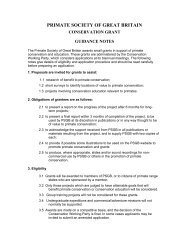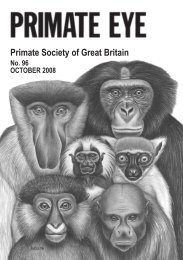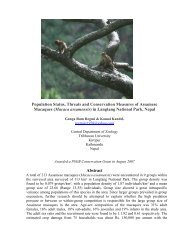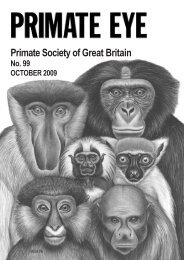2010 Vol 101.pdf (1.63mb) - Primate Society of Great Britain
2010 Vol 101.pdf (1.63mb) - Primate Society of Great Britain
2010 Vol 101.pdf (1.63mb) - Primate Society of Great Britain
You also want an ePaper? Increase the reach of your titles
YUMPU automatically turns print PDFs into web optimized ePapers that Google loves.
consistently observed conspecifics with the same eye. There exist two<br />
competing theories that posit the lateralisation <strong>of</strong> emotion within the brain:<br />
one suggests right-hemisphere dominance in the interpretation and<br />
expression <strong>of</strong> all affective states (Campbell, 1982), whilst the other<br />
contends that the right hemisphere is responsible for negative emotion alone<br />
whereas positive emotion is regulated by the left hemisphere (the Valence<br />
Hypothesis; Davidson, 1992) but the almost exclusive investigation <strong>of</strong><br />
aggressive/fearful scenarios prevents objective evaluation <strong>of</strong> these<br />
competing theories. This study addresses the problem by considering<br />
interactions across the full spectrum <strong>of</strong> emotion, testing both theories whilst<br />
also considering whether the strength <strong>of</strong> emotional intensity can be<br />
correlated to lateral bias, and whether age-sex effects exist.<br />
Composition <strong>of</strong> vigilance periods in gorilla (Gorilla gorilla) social play<br />
J.A. Mayhew and J.C. Gómez<br />
School <strong>of</strong> Psychology, University <strong>of</strong> St Andrews<br />
Gorilla (Gorilla gorilla) play bouts are complex and dynamic social<br />
interactions that incorporate locomotory movements and behaviours from<br />
outside social contexts such as aggression or predation. Such diverse bouts<br />
are typically punctuated with intermittent periods where the close physical<br />
activity between the interacting individuals seems to momentarily conclude.<br />
During these cessations, or “vigilance periods”, the play partners may break<br />
contact and give pause to their physical interaction, may readjust their body<br />
positioning, move in or out <strong>of</strong> proximity from their partner, or they may<br />
transition from one type <strong>of</strong> generalized play pattern to another. This study<br />
presents a preliminary examination <strong>of</strong> the structure and composition <strong>of</strong><br />
vigilance periods taking into account several variables including eye gaze,<br />
head orientation, body orientation and posturing <strong>of</strong> the interacting<br />
individuals. Specific organization <strong>of</strong> these subtle social cues may be<br />
essential for initiating, maintaining, and terminating play and may also shed<br />
light on the advantages and preferences <strong>of</strong> using certain social cues over<br />
others. During vigilance periods, young gorillas might learn about the social<br />
cues that signal attention and intention in others as well as in themselves<br />
and an investigation <strong>of</strong> these periods can be useful in further exploring what<br />
social cognitive functions social play may have for young gorillas.<br />
Can hand and footpad morphology distinguish slow loris taxa?<br />
C. J. Wheeler, R.A. Munds and K.A I. Nekaris<br />
Nocturnal <strong>Primate</strong> Research Group, School <strong>of</strong> Social Sciences and Law,<br />
Oxford Brookes University<br />
Once considered a widespread homogeneous taxon, a minimum <strong>of</strong> five<br />
species <strong>of</strong> slow loris (Nycticebus) are now recognised based on genetic,<br />
23






